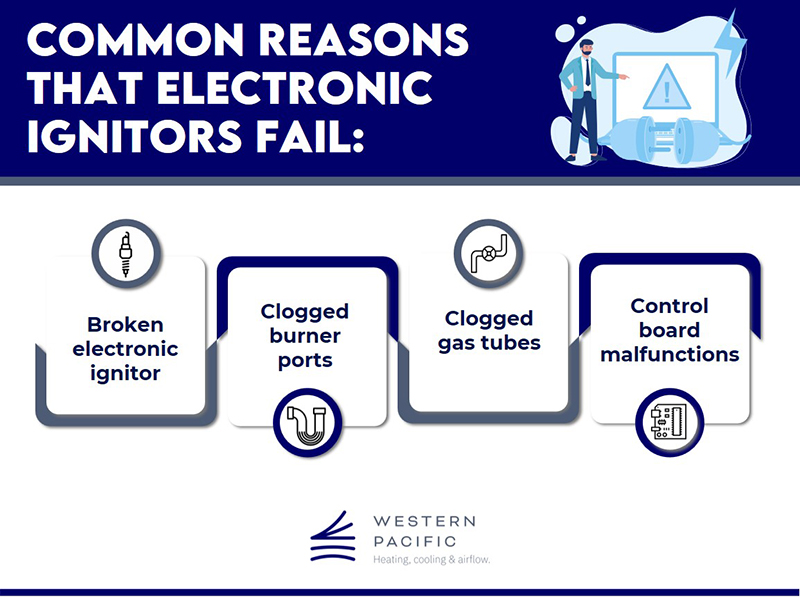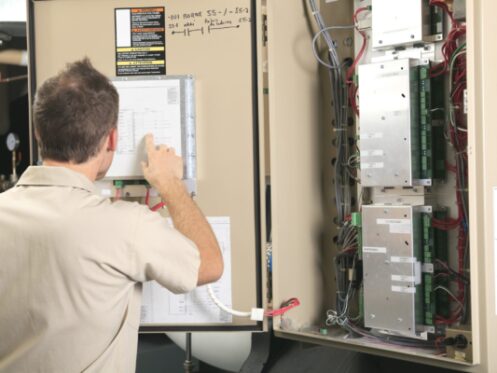Unless your furnace is quite old, it most likely uses some type of electronic ignitor to light the unit’s gas burners. If your electronic ignitor fails or malfunctions, your furnace won’t be able to generate warm air.
Electronic ignitors can fail to light for various reasons. Sometimes the problem is due to an issue with the ignitor itself. Sometimes it can happen because of some other issue with your furnace. Here is a complete overview of how different types of electronic ignitors work, what to do if your ignitor won’t light your furnace, and what issues can cause an electronic ignitor to fail.
Hot-Surface Ignitors, Intermittent Pilot Lights, and Standing Pilot Lights
In the past, all gas furnaces used a standing pilot light to ignite their gas burners. The problem is that standing pilot lights are not energy efficient as they have to constantly burn a small amount of gas to keep the flame lit. A standing pilot light typically burns just over 40,000 BTUs worth of gas each month, which means it would usually cost you at least $4 to $5 each month just to keep the pilot light going.
This lack of energy efficiency is why virtually all modern furnaces use either a hot-surface ignitor or an intermittent pilot light instead of the traditional standing pilot light. An intermittent pilot light works almost exactly the same as when you relight a standing pilot light. Whenever the furnace turns on, the intermittent pilot automatically produces a spark that lights the gas flowing through it to create a flame that then lights the burners. The pilot light automatically goes out when the furnace shuts down so it doesn’t waste fuel.
Hot-surface ignitors are even more energy efficient than intermittent pilot lights. A hot-surface ignitor uses electricity to produce heat that lights the burners. Hot-surface ignitors are similar to light bulbs in that electricity flows through a small filament. The filament almost instantly becomes red-hot and produces enough heat to ignite the gas flowing out of the furnace’s burners.
What to Check For If Your Furnace’s Electronic Ignitor Isn’t Working
As we previously said, a furnace can fail to light for various reasons, many unrelated to the electronic ignitor itself. If the electronic ignitor is the problem, you will need to have your furnace inspected and possibly have the ignitor repaired or replaced, as there is simply no way for you to know if the ignitor is the issue. However, before you call to have your furnace serviced, there are a few things you should check for first, as you may be able to solve the problem on your own if the issue isn’t related to the ignitor.
If your furnace ever fails to turn on, the first thing to do is check to see if it tripped the circuit breaker. If the breaker is tripped and no electricity flows to the furnace, the electronic ignitor won’t work. If the breaker isn’t tripped, you should turn the fan setting on your thermostat to “On” so the fan will come on even though the furnace isn’t running. If the circuit breaker isn’t tripped and the fan won’t turn on, it usually means there is a problem with the furnace’s wiring or the wiring that runs between the furnace and the thermostat.
The next thing you’ll want to do is replace your furnace filter. If the filter is too dirty, it can cause the furnace to overheat and trip the unit’s high-temperature limit switch. Should this happen, the furnace won’t come on again until the limit switch detects it has cooled enough to be safe to operate again. In some cases, you may also need to reset your furnace if the limit switch trips.

If you have a high-efficiency condensing furnace, after replacing the air filter, you’ll want to open the door on your furnace and check that the drain pan isn’t full of water. If you have a conventional furnace, you can skip this step, as this type of unit doesn’t have a drain pan since it doesn’t produce condensation.
Condensing furnaces have a float switch inside the drain pan. This will trigger the furnace to shut off if the drain pan becomes too full to prevent the water from overflowing and potentially damaging the furnace. If the float switch triggers, the furnace’s control board won’t signal the ignitor to turn on.
If the drain pan is full, you can try to soak up all the water with towels or use a shop vac to empty the pan. Once the pan is empty, the float switch will deactivate, and your furnace should then run. If the drain pan fills up again and triggers the float switch, you’ll need to have a technician check the furnace’s condensate drain system as one of the pipes is most likely clogged.
Sometimes, a furnace’s electronic ignitor will simply need to be reset due to a power surge or some other issue. The ignitor can be reset by turning the power to the furnace off by flipping the circuit breaker, opening the furnace, and flipping the ignitor switch to Off. After waiting about five minutes, the ignitor can be turned back on and the circuit breaker reset.
While you may be able to reset the ignitor on your own, we recommend having a technician perform this task. They will also be able to test to make sure the ignitor is working correctly and inspect for any other issues at the same time.
Common Reasons That Electronic Ignitors Fail
If a technician determines the electronic ignitor on your furnace is broken or has worn out, replacing it is usually a fairly simple fix. Electronic ignitors can wear out simply because of age. Like any other furnace component, they can also be damaged due to overheating or a power surge. This is especially true for hot-surface ignitors, as they are quite fragile.
There are also times when the furnace won’t ignite immediately because the burner ports are clogged or the ignitor malfunctions. This typically leads to gas beginning to fill up the combustion chamber. When the burners finally light, all the gas can result in a small fireball or explosion that can ruin the ignitor.
On intermittent pilot lights, the gas tube can sometimes get clogged with debris and prevent the ignitor from lighting. A furnace’s control board can also malfunction or burn out. A burnt-out control board will prevent the furnace from working at all. If the control board malfunctions, it may also fail to signal the hot-surface ignitor to shut off which can lead to the ignitor burning up.
At Western Pacific Heating, Cooling & Airflow, our expert technicians can help if you need to replace your furnace’s electronic ignitor. We also offer furnace and AC repair and maintenance services. We specialize in HVAC installation and install furnaces, air conditioners, heat pumps and whole-home air purification systems. Give us a call today if you need to have your furnace inspected or any other HVAC service in the Vancouver area.
Contact Western Pacific Heating, Cooling & Airflow today!

